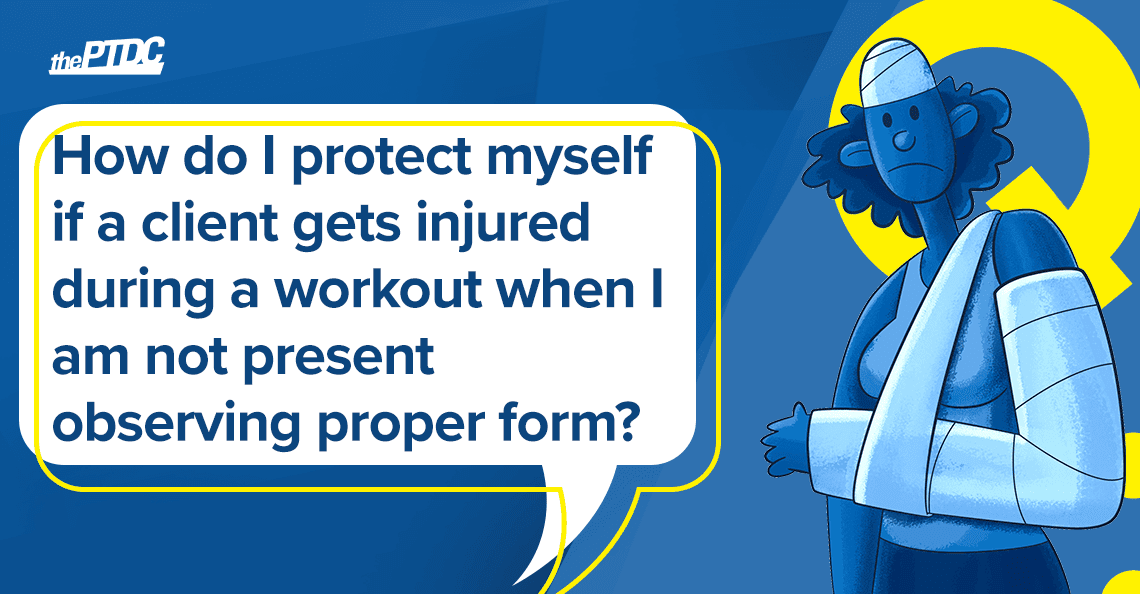
To protect yourself if a client gets injured during a workout—when you were not present observing proper form—all you need are three legal documents, and one big personal attribute:
Common sense.
We’ll get to the three legal documents in a minute—it’s just straightforward protection. But using common sense means you’ll probably never need that legal protection.
I can say that confidently. The odds of a good, responsible online personal trainer getting taken to court by a client are so slim that I’ve never actually heard of it happening.
(There have been lawsuits against negligent trainers, but in the cases I’ve read about, frankly, the trainer deserved it.)
How’s your common sense? Here’s a great way to test it. I got it from the legendary trainer Mike Boyle.
It’s called the courtroom test.
Imagine yourself in front of a jury.
You stand accused of causing an injury by instructing a client to perform a certain exercise.
This jury doesn’t know anything about exercise.
Your task: Justify to the jury why you chose this exercise for this client.
Could you do it?
If you’re a certified trainer who puts thought into your programming, this should be a slam dunk. Of course you had a good reason for this exercise—and your reasons are backed by science and experience.
Let’s take an example: Hitting a tire with a sledgehammer. Would that pass the courtroom test?
Absolutely not.
I mean, it can be a fun exercise, and if you like it, go ahead and do it. But don’t give it to an online client!
You could never justify to any jury ever that sledgehammering a tire was the safest, most responsible, and most effective exercise for that client to help achieve his goal.
It’s kind of like adding pineapple to pizza. If you like it for yourself, do it, but know that it is objectively and definitively the wrong thing to do.
Whenever you’re building a program for an online client, run every single exercise through the courtroom test.
Ask yourself:
Is there a safer exercise that’s just as effective?
That’s the key. As long as you can reasonably justify why you chose something, you’re never going to be in trouble.
Now, let me slip on my tweed jacket and play law professor for a moment while I summarize the commonsense principles of online training.

Don’t program dumb stuff.
Got it? Avoid the stupid, think things through, and you’ll have nothing to worry about.
That said, let me get back to the three basics of legal protection. You’ve read about these elsewhere, but here’s a refresher course.
Three legal documents every online personal trainer needs
1. The PAR-Q
This is the familiar Physical Activity Readiness Questionnaire that all potential clients must fill out before you start training them. Clients fill one out at a gym, and they must fill one out if they’re going to become an online client.
It’s a list of basic medical warning signs, and you want to see all “No’s.” You can google a free one that you’re allowed to use.
2. A personal training waiver form
This is language in your terms of service contract that waives liability in case something happens. It basically means the client waives the right to sue you.
This isn’t going to protect you if you're negligent, but you need it if there were ever to be any kind of a legal case against you. As I said, the chances of that are small.
The language of this “release of liability” can look daunting. But when a client signs it, they’re just saying that they’ll follow your directions and that they recognize the risks. (Now if we can only get them all to follow our directions!)
3. Professional liability insurance
One-to-two million dollars’ worth is plenty.
Make sure the policy says you’re covered for clients that you have never seen in person. The typical language says you have to do an in-person assessment before you can deliver information remotely.
If you’re going to train people without doing an in-person assessment, make sure that language is written into the policy.
-----
So that’s it—three bits of paperwork protection and one big umbrella of common sense.
One last thing to remember: Your online clients are just amateurs. But often they’re enthusiastic amateurs. And you’re enthusiastic, too.
We trainers can get wrapped up in circus-type exercises. A client shouldn’t perform those movements without a long, logical progression leading up to them.
You like those movements, sure, but you’ve been training for years. Your client probably hasn’t.
Use common sense. Justify every exercise.
If you can truthfully tell yourself, “Based on everything I know, this is the safest exercise that I could prescribe to help them achieve their goal,” then you’re going to be fine.
Learn more: Get answers to more online trainer questions.










